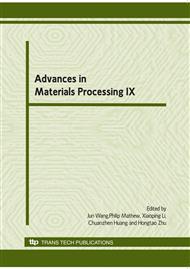[1]
R. A. Scott: Textile for Protection (Woodhead Publishing, United Kingdom 2005).
Google Scholar
[2]
X. Flambard and J. Polo: JOURNAL OF ADVANCED MATERIALS, Vol. 36 (2004), p.30.
Google Scholar
[3]
C.W. Lou, C.M. Lin, C.H. Hsu, H.H. Meng, J.M. Chen and J.H. Lin: Journal of Advanced Materials, Vol. 40 (2008), p.27.
Google Scholar
[4]
J. H. Lin, C. W. Lou, J. M. Chen, C. T. Hsieh and Z. H. Liu: Advanced Materials Research, Vol. 55-57 (2008), p.433.
Google Scholar
[5]
C. C. Lin, C. W. Lou, W. H. Hsing, W. H. Ma, C.M. Lin and J. H. Lin: Advanced Materials Research, Vol. 55-57 (2008), p.429.
Google Scholar
[6]
J. M. Chen, J. C. Hsieh, C. W. Lou, W. H. Hsing, H. J. Yang and J. H. Lin: Advanced Materials Research, Vol. 55-57 (2008), p.417.
Google Scholar
[7]
C. W. Lou, C. W. Lin, C. C. Lin, S. J. Li, I. J. Tsai and J. H. Lin: Advanced Materials Research, Vol. 55-57 (2008), p.405.
Google Scholar
[8]
C. H. Lee, C. W. Lou, W. H. Hsing, I. J. Tsai and J. H. Lin: Advanced Materials Research, Vol. 55-57 (2008), p.401.
Google Scholar
[9]
C. K. Lin, C. W. Lou, C. T. Lu, C. C. Huang and J. H. Lin: Advanced Materials Research, Vol. 55-57 (2008), p.397.
Google Scholar
[10]
C. W. Lou, P. Chen and J. H. Lin: Advanced Materials Research, Vol. 55-57 (2008), p.393.
Google Scholar
[11]
M. C. Lu, C. Y. Ho, S. F. Hsu, H. C. Lee, J. H. Lin, C. H. Yao and Y. S. Chen: Neurorehabilitation And Neural Repair, Vol. 22 (2008), p.367.
Google Scholar
[12]
C. W. Lou, C. H. Hsu, H. H. Meng, J. M. Chen, C. W. Lin and J. H. Lin: Textile Research Journal, Vol. 78 (2008), p.258.
Google Scholar
[13]
C. W. Lou, Y. C. Lee, I. J. Tsai, C. H. Lei, J. M. Chen and J. H. Lin: Journal of Advanced Materials, Vol. 40(2008), p.33.
Google Scholar
[14]
I. J. Tsai, C. H. Lei, C. H. Lee, Y. C. Lee, C. W. Lou and J. H. Lin: Journal of Materials Processing Technology, Vol. 192-193(2007), p.415.
Google Scholar
[15]
C. W. Lou, C. W. Lin, C. H. Lei, K. H. Su, C. H. Hsu, Z. H. Liu and J. H. Lin: Journal of Materials Processing Technology, Vol. 192-193(2007), p.428.
Google Scholar
[16]
T. K. Ghosh: Geotextiles and Geomembranes, Vol. 16 (1998), p.293.
Google Scholar
[17]
L. Huang, E. Allen, and A. E. Tonelli*: Polymer, Vol. 40 (1999), p.3211.
Google Scholar
[18]
ASTM F1342-05 Standard Test Method for Protective Clothing Material Resistance to Puncture (2005).
Google Scholar


